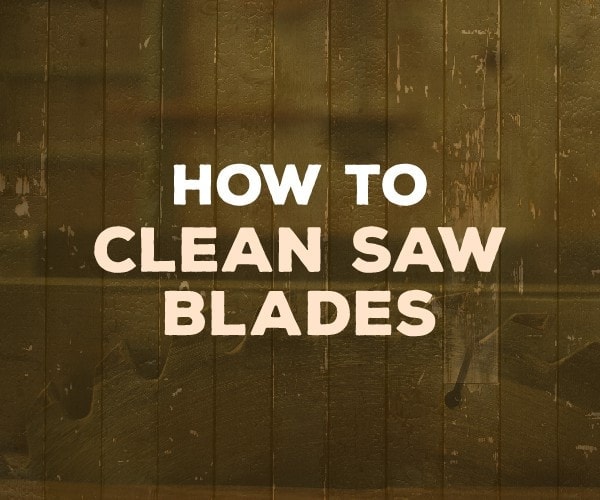If you’re like me, you spend a large chunk of your time at work using various power saws to cut all sorts of materials from wood to metal to plastic, and anything in between. Saw blades are designed to stand up to the worst you can dish out (as they should, considering how expensive they are!)
But, over time, it’s easy for the blade in your table saw, circular saw, miter saw (or any other saw for that matter) to become caked with resin, pitch and other materials that build upon the surface of the blade. Many craftsmen mistake this process for a dulling of the blade and purchase a new blade to replace their existing one.
In many cases, replacing your saw blade is unnecessary, and you can get back to the results you were achieving when your blade was brand new with a little bit of elbow grease. Today, we’ll cover how to clean saw blades, so you can stop wasting your hard-earned money on new blades you probably don’t need.
What You’ll Need
Learning how to clean saw blades is easy, and you’ll require just a few cleaning materials to get the job done, in addition to the cleaner of your choice. There are a few different products on the market that do a great job of cleaning saw blades.
You’ll find a few products specifically made for cleaning saw blades, such as Rockler Pitch & Resin Cleaner. This stuff works great, but so does virtually every other cleaner/degreaser.
Oven cleaner is another popular option for cleaning saw blades. However, oven cleaner is also toxic, so you may want to consider it as a last resort. You may want to experiment with different cleaners before deciding on the best one for your needs.
If you’re unsure which saw blade cleaner to go with, Wood Magazine’s comprehensive review can point you in the right direction.
- Any cleaner/degreaser (Simple Green, Rockler Pitch & Resin Cleaner, or oven cleaner all work well)
- Tupperware large enough for your saw blade
- 00 steel wool
- Brass brush
- Shop towels
- Blade lubricant
- Air compressor (or a can of compressed air)
Step I: Removing the Saw Blade
The first thing you’ll need to do is remove your blade from the saw. Depending on the saw you’re working on, the way you’ll remove the blade will be different.
Chances are, you can find a Youtube tutorial that shows you exactly how to remove your blade if you’re not sure how to do it.
Step II: Mixing the Cleaning Solution
Almost any cleaner you’ll find that will work well on your saw blades is sold in a concentrate that should be diluted before use.
First, read the directions on the bottle to see their recommendation for how you should dilute the product. If your blades are looking relatively clean, to begin with, follow the directions on the bottle. But, if your blades are caked in resin and pitch, you may want to consider diluting the cleaner less, or not diluting it at all.
Once you’ve mixed your cleaning solution, pour it into a container that’s large enough to accommodate your blade. Some companies make bowls that are the perfect size for cleaning saw blades. If you can’t find one, you’ll need to get creative. When I clean my blades, I just use a large Tupperware (don’t tell my wife) that I stole from the kitchen.
Step III: Cleaning the Blades
With your cleaning solution ready to go, just drop your blade inside the container and make sure that it’s completely submerged in the cleaning solution.
Now is a good time to grab a cup of coffee, as you’ll want to leave your blade soaking in the cleaning solution for at least five minutes. If the blade is heavily caked with gunk, give it an extra few minutes in the cleaning solution.
After the blade has soaked in the solution for several minutes, you can remove it and continue the cleaning process. For this part, you’ll need some abrasives, like a brass brush and some steel wool or Scotchbrite cloth.
At this point, you’ll want to take a deep breath and enter “thinking about safety” mode. You’re dealing with a saw blade, and your fingers will be close to the teeth. Work slowly and carefully to avoid cutting yourself.
Starting with the brush, begin to work each of the teeth on the saw blade, paying extra attention to areas where you can see the layer of junk on your blade. Once you’ve given a thorough brushing to your blade move on to steel wool or Scotchbrite. This is the most dangerous step in the cleaning process, so be extra careful when you’re working around the teeth.
For really stubborn spots, feel free to add a little bit of undiluted cleaning solution to your steel wool to make it easier to lift that junk off your blade.
Once your blade is thoroughly cleaned, take a shop towel and dry the blade the best you can. Once the blade is dry, I use my air compressor to blow any residual drops of water that may have gotten caught in the crevices of the saw blade. If you don’t have one, a can of compressed air will do the trick.
Step IV: Lubricating Your Blade
Not only did the cleaner remove all the gunk from your blade, but it also removed any lubrication the blade may have had. Before you use the blade again, it’s a good idea to apply a light coat of lubricant to the blade.
I use a saw blade lubricant stick for this, but spray lubricants work just as well; use whatever you feel comfortable with.
Final Word
When it comes to how to clean saw blades, the name of the game is elbow grease and patience. With some basic household supplies and a little scrubbing, you’ll have your saw blade restored to glory in under a half hour.

